I
open here a very short parentheses not closely tied to the stamps but to a
particular way of their use. Because, as I explained several times, this site
will not deal in great detail on postal history subjects, in this "exception
to the rule" I will limit myself to a very short and quite superficial
mention.
I wanted to talk at least shortly on the subject "Levant" because
it is of big importance in relationship with the use of the Lombardy-Venetia
postage stamps.
It
happens often looking at the stamps of IV and V issue to find cancellation
with names that are not easy to understand or not part of the "Italian"
(let me use this term here...;) territory of the Lombardy-Venetia. They are
often cancellations of Postal Offices of the so-called "Austrian Levant".
Already from 1700 the Austrian Empire opened offices and addresses in the
very large Turkish/Ottoman territory to improve or make easier the postal
communications from and to their territory and therefore reinforce the commerce
and their own connections network: let's not forget that at that time the
postal and commercial connections were not so capillary and extended as they
are today!
But it is only at the beginning of the 1800 that a fundamental push to transportation
and to the commerce, and therefore to the postal movement, was given by the
creation of the "Danube Company". It was funded by two English
businessmen (John Andrews and Joseph Pritchard) and it is known with the initials
"DDSG" (Erste Donau Dampfschiffahrts-Gesellschaft).
It started its service along the Danube river in 1830 with the "Franz
I", a steamboat "modernized" in Vienna.
To the DDSG, in short time, the "Lloyd Austriaco" (that even
today exist as "Lloyd Triestino" and it's one of the oldest
shipping companies) was added: it was funded in 1833 as insurance company,
on the English model, with the purpose to give services and info to merchants
that were trading between Europe and Asia. It was immediately given a lot
of importance to the connections "by water" to the point that already
in 1837 (May 16 with the steamboat "Arciduca Lodovico") the
service to Costantinopoli was started. Already in 1838 the Lloyd fleet was
composed by 10 steamboats.....
There
was therefore the opportunity to use the transportation by river and by sea,
much faster and efficient that the one by land. The Lloyd in particular assumed
quickly a very prominent international importance to the point to have its
own cancellations in the agencies. Several other offices were in the mean
time established.
When in 1850 the stamps were introduced both in Austria and in the Lombardy-Venetia,
this new thing was not adopted for the mail leaving from the Levant offices
and this due to various differences in currencies and language that would
have created a huge confusion. The mail continued to travel without postage
stamps and the fee was paid at the arrival in cash.
Only between 1863 and 1864 the use of stamps that in the mean time was consolidated
and more and more adopted by the international community, was extended to
the Levant Austrian Postal offices that were then "refurnished"
with stamps.
The decision was to use the stamps already circulating on the Italian territory,
probably for the large diffusion of the Italian language in the interested
territories. The cuts in use of the IV e V issue with the values in Soldi
were distributed. Their utilization went on even after the 3rd Independence
war that saw the annexation of the Veneto to the Italian Kingdom and last
until 1869 even if already from 1867 a new issue of the Austrian type, but
always with values in Soldi, was put in circulation...
The
study and collection of these cancellations is very important even if not
fully appreciated by the collectors.
Some (few...) cancellations are relatively common, but several are extremely
rare and if only the market would look at them with more interest their availability
in some cases would be extremely difficult.
To that must be added the spectacular multicolor postage that are found much
easily in comparison to the Lombardy-Venetia ones (even if this does not mean
that they are common...) and the mixed use with stamps from other States that
make any collection more precious.
I show here the map of the Levant territory where the postal offices were
opened, from which it is possible to see its huge extension (Fig. 1).
It does extend from today Romania and Bulgaria up to the Turkey, to Cyprus,
to Iraq, to Palestine, to Egypt.
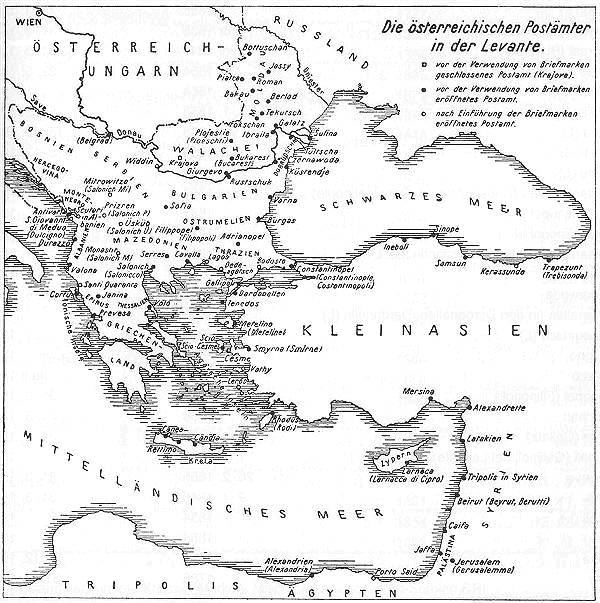
Fig. 1:
the Austrian Levant territory
(from "Catalogo Ferchenbauer 2001")
I show here the list of the postal offices that cancelled the stamps (limited to the Lombardy-Venetia values), neglecting all the minor types, the varieties and the accessory cancellations. I give only the main name of the office without mention the several ways that name can be found written (just to make an example the Costantinopoli cancellation can be found under "Constantinople", "Constantinopel", "Costantinopoli Lloyd Agenzie", with cancellation of color and shape different from each other...). May be by checking some sample of your collection you may find that the stamp comes from a place much more far away that what you were thinking. I hope to have them all listed... (in alphabetic order from left to right).
|
Adrianopel
|
Alexandria
|
Antivari
|
|
Argostoli
|
Bakeu
|
Beirut
|
|
Berlad
|
Botuschan
|
Bucarest
|
|
Burgas
|
Caifa
|
Candia
|
|
Canea
|
Cavalla
|
Corfu
|
|
Costantinopoli
|
Czernawoda
|
Dardanelli
|
|
Durazzo
|
Filipopoli
|
Fokschan
|
|
Galatz
|
Gallipoli
|
Gerusalemme
|
|
Giurgevo
|
Ibraila
|
Ineboli
|
|
Jaffa
|
Janina
|
Jassy
|
|
Kustendje
|
Lagos
|
Larnaca
|
|
Latakien
|
Meteline
|
Piatra
|
|
Plojestie
|
Porto
Said Egypten
|
Prevesa
|
|
Rettimo
|
Rhodus
|
Roman
|
|
Rustschuk
|
Salonich
|
Scio-Cesme
|
|
Scutari
d'Albania
|
Serres
|
Sinope
|
|
Smirne
|
Sofia
|
Sulina
|
|
Tekutsch
|
Tenedos
|
Trebisonda
|
|
Tultscha
|
Valona
|
Varna
|
|
Volo
|
Widdin
|
And
finally I show here for curiosity some piece used in Levant (Fig. 1 to
15), without a clear logic but only to give some example of these stamps.
Who knows? may be some collector will decide to give in the future more attention
to this segment so fascinating and reach of so many surprises...
I close here this short parenthesis that "strangely enough" I left
going by... I don't think that it went unnoticed that I always liked these
stamps...
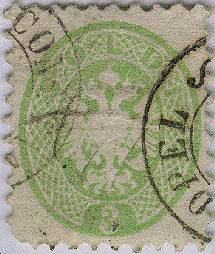 |
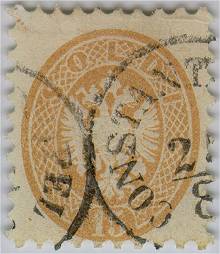 |
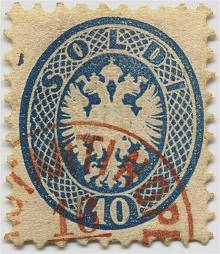 |
|
Fig.
1: COSTANTINOPOLI
(double circle, black) |
Fig.
1a: COSTANTINOPOLI
(simple circle, black) |
Fig.
1b: COSTANTINOPOLI
(simple circle, red) |
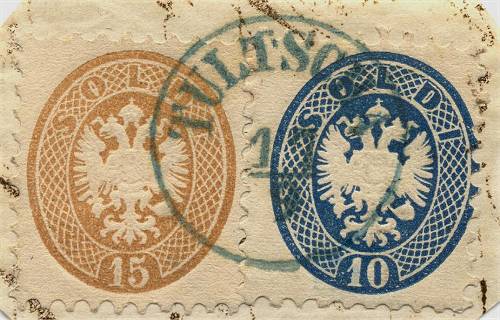
Fig.
2: TULTSCHA
(simple circle, blue)
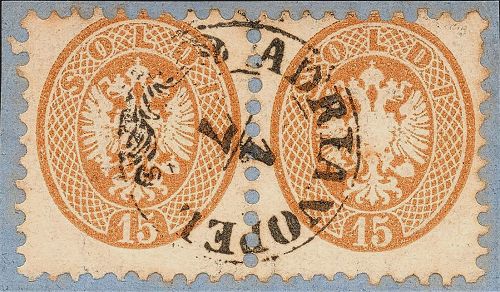
Fig.
3: ADRIANOPEL
(double circle with fluorish, black)
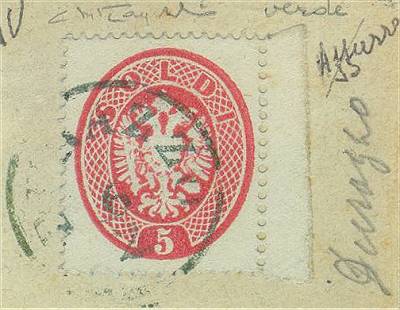
Fig.
4: DURAZZO
(simple circle, green-bluish)
The stamp presents also the right sheet margin: there are very few
existent samples with that detail
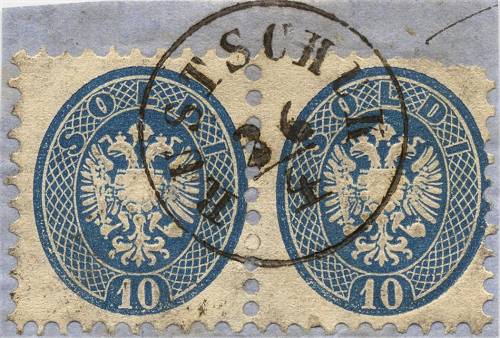
Fig.
5: RUSTSCHUK
(simple circle, black)
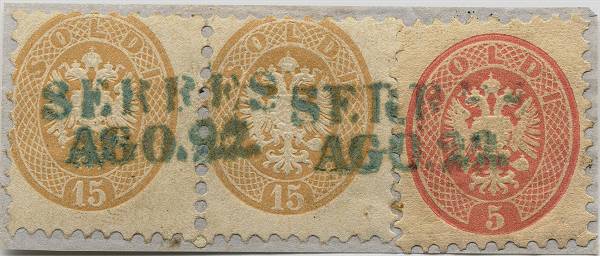
Fig.
6: SERRES
(linear, blue-greenish)
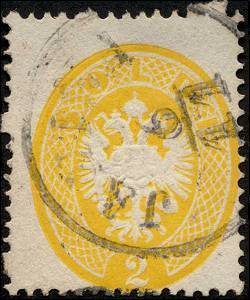 |
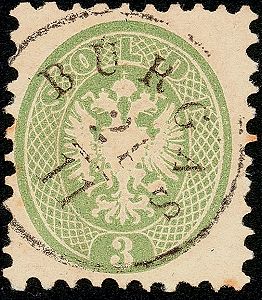 |
|
Fig.
7: JANINA
(simple circle, black) |
Fig.
8: BURGAS
(simple circle, balck) |

Fig.
9: a strip of four of the 10
soldi cancelled "LLOYD AGENZIE KUSTENDJE"

Fig.
10: the 4th issue
complete, used in Levant (BUCARES and COSTANTINOPOLI)

Fig.
11: the 5th issue
complete, used in Levant (COSTANTINOPOLI and ALESSANDRIA)
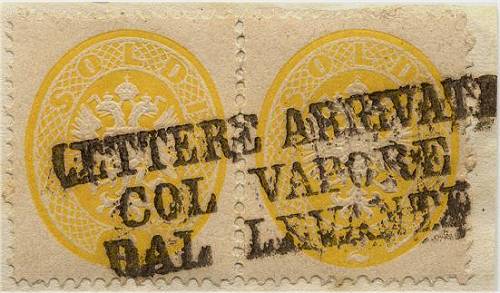
Fig. 12: accessory cancellation in use in Trieste for the letters
coming from Levant
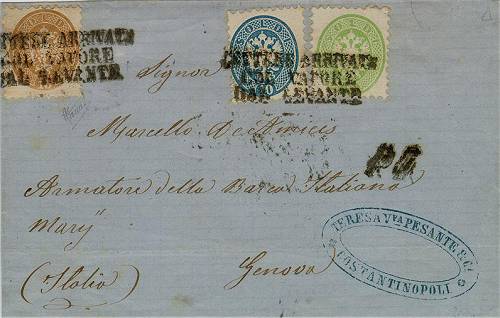
Fig. 13: marvellous tricolor franking from Costantinopoli to Genova,
through Trieste
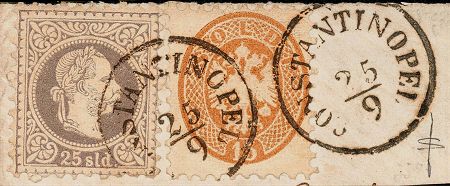
Fig. 14: mixed franking between the 5th issue of Lombardy-Venetoia
and the 1st issue for the Levant.
Simple circle cancellation of COSTANTINOPOLI
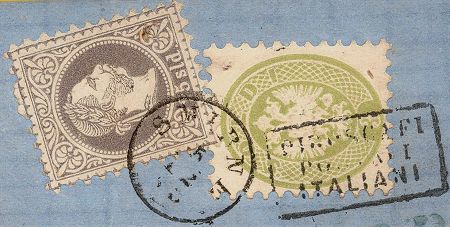
Fig. 15: mixed franking between the 5th issue of Lombardy-Venetoia
and the 1st issue for the Levant.
SImple little circle cancellation of SMIRNE + squared "PIROSCAFI POSTALI
ITALIANI"